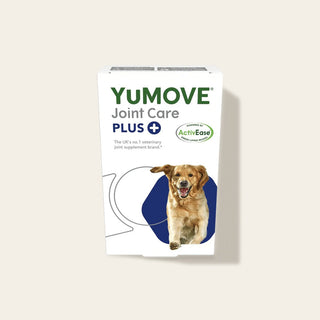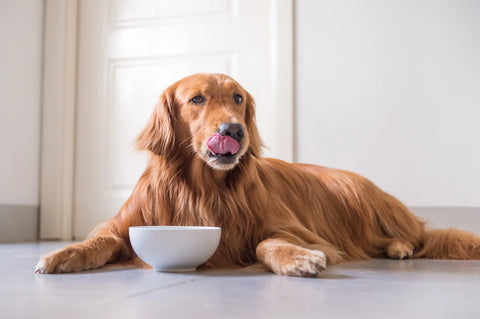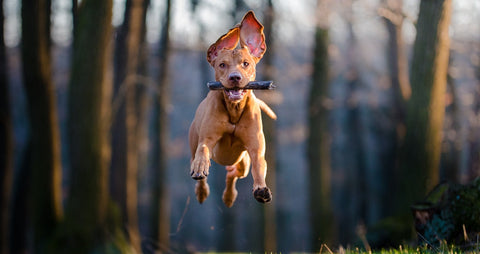

How to help a choking dog
It’s often difficult to know whether something’s stuck in your dog’s mouth or if they’re simply just clearing their throat. Choking in dogs isn’t very common, and a coughing dog can easily be mistaken for a choking one.
What’s more, choking in dogs to the point where their airways are completely blocked is rare, but if you are unlucky enough to have this happen to your dog, you need to be fully prepared. At YuMOVE, we’re here to arm you with all the information needed to spot when your dog is choking and to figure out when to step in. Let’s take a closer look…
Our top tip: Before we kick things off, we always recommend calling your vet as soon as possible if you can’t safely remove an object from your dog’s throat. That means if your dog is choking right now, don’t waste precious time reading this guide, and get on the phone!
The signs your dog is choking
Choking happens when something gets stuck in the back of your dog’s throat and blocks their airways, preventing them from breathing. Dogs are more likely to choke on long-lasting chews, toys and balls. This is because they’re able to bite off small pieces of these items. Catching balls, sticks or food in the air can also increase the risk of your dog choking. If you notice your dog coughing after chewing on one of these things or catching an object mid-air, you should intervene straight away. Here are a few other tell-tale signs of choking:
- Retching or gagging
- Blue lips or gums
- Pacing back and forth
- Pawing at the mouth
- Whining
- Visible signs of struggling
- Excessive drooling
- Difficulty breathing
- In the most severe cases, your dog might even pass out
How to help a choking dog
Step one: Figure out if they’re choking or just coughing
When choking, your dog will struggle to breathe. If they’re just coughing, they will still be able to breathe in. It’s possible that they’re choking if they’ve just been playing with a toy, or munching on a chew.
Step two: Try to remove the object

As we said above, it’s not very common for dogs to choke. The most important thing is not to panic. This will help to keep your dog calm, too. We never recommend putting your fingers into your dog’s mouth when they’re conscious. In most cases, you won’t be able to grip the object properly, and your pet is likely to bite down on your hand.
It’s also important that you should never attempt the Heimlich manoeuvre on your pet. Most dogs don’t have the right body shape for it, and you run the risk of breaking ribs or getting bitten.
Instead, follow these simple steps to try to move the object out of their airways:
- Stand behind your dog and put your thumbs below their jaw
- Gently push upwards on their throat to try and dislodge the item
By doing this, you’ll may be able to push the object out of the way and hopefully free up their airways.
Note: If this doesn’t work after a few attempts, call your vet immediately. Don’t
keep trying if it’s not working.
What to do next
Try to remain calm. This is important for everyone – dogs and humans alike. Call your vet straight away, or ask someone else to do it while you attend to your dog. It’s essential that your canine is checked thoroughly by a trained professional. The after-effects of a choking incident can sometimes be just as severe as the choking itself.
When something gets stuck in your dog’s throat, it can cause some serious damage to the inside of their mouth or their oesophagus. It can also take a few days to heal, so your vet may prescribe pain relief. Your vet might also perform some X-rays to make sure that there’s nothing left in the windpipe or digestive system.
How to prevent your dog from choking
- Use common sense. Don’t assume your dog will instinctively know to chew something into smaller bites instead of simply swallowing it whole.
- Play with the right-sized toys. Inappropriately sized balls can obstruct airways. You should also consider using balls with holes in them. And never throw toys or food for your dog to catch in the air.
- Don’t give your dog cooked bones. These become brittle when cooked and can easily break into shards in your dog’s mouth.
- Feed them appropriate food. Always choose food that’s made specifically for your individual dog – whether they’re old or young, big or small.
- Don’t play fetch with sticks. You might be surprised to hear this, but the common stick poses many dangers for dogs. Plus, if your dog is a serial biter, the stick can be broken down into smaller pieces and can cause choking.
Important to note
This guide should not be used in place of some thorough pet first aid training. First Aid for Pets is an award-winning and market-leading pet first aid course. The best part? It’s all done online.
Want more practical guidance on looking after your dog? Check out the other guides in our Pet First Aid series: dehydration in dogs, poisoning in dogs, heat stroke in dogs and canine mental health.



